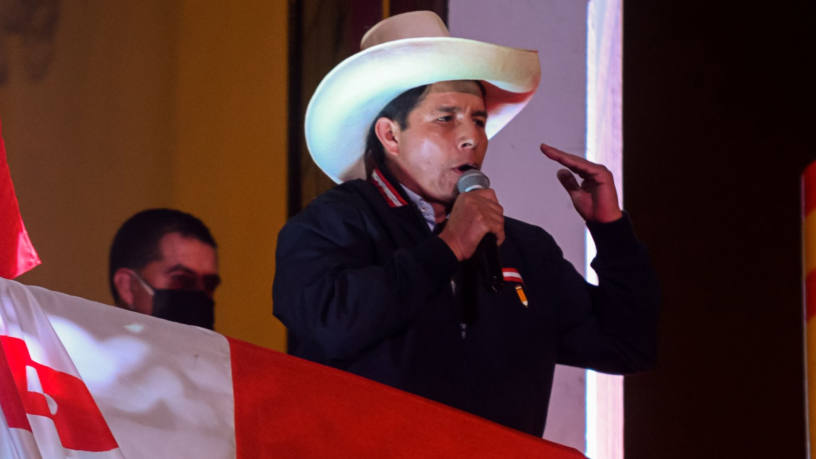Peru’s new government faces one of the most daunting transitions in decades, having to carefully manage internal political pressures that could unbalance the country’s rebounding economy and its pandemic response.
President Pedro Castillo, a political neophyte from the left-wing Peru Libre party, defeated conservative candidate Keiko Fujimori by a razor-thin margin of 44,200 votes. Ms Fujimori, making her third bid for the top office, refused to concede and her supporters have vowed that they will continue to fight.
This is a near-repeat of 2016, when Ms Fujimori lost by a similar margin and her Popular Force party went after the government, contributing to the political dysfunction that led to Peru going through three presidents in a week in November 2020.
The pandemic has raged alongside the political crisis, making Peru one of the hardest-hit countries in the world with the highest per-capita mortality rate from Covid-19, according to international trackers.
The Castillo government has to find a way to work with Congress and political parties to manage growth, while dealing with the multiple problems created by years of political gridlock and the pandemic-induced recession.
Richard Francis, a director at Fitch covering Latin American sovereigns, says the crisis has exposed numerous issues that the government has to tackle.
“They will have to find a way to increase revenue to pay for social spending that is definitely needed,” he says. “And they have to figure out how to get from A to B without blowing out their fiscal and debt position.”
Revenue search
The fiscal deficit this year is forecast at 5.4% of gross domestic product (GDP), while the public debt will reach 35.9%, according to the government, making increased revenue a primary concern.
Peru has one of the lowest tax-to-GDP ratios in the region, and tax revenue in 2020 was only 13% of GDP. That is slightly below the average of 14% over the past 50 years, according to the country’s ministry of economy and finance. Peru has the highest level of income tax and VAT evasion among the region’s large economies.
The Castillo government, which had only a short time to prepare for transition, has not provided specifics on its plans, but advisors have mentioned a few potential plans, including higher taxes for mining, eliminating loopholes to reduce tax evasion and elusion, and instituting a wealth tax. Peru would be following Argentina and Bolivia, which implemented wealth taxes in December. Chile’s Congress rejected a similar plan in May.
The fiscal position is complicated. Fiscal support is still needed for the pandemic and for exiting the pandemic
Several strategies exist regarding the mining industry, including the option of reviewing tax stability agreements signed with large-scale mining companies. There are 25 agreements in place, but eliminating them would be difficult and could lead to international arbitration.
Increasing taxes on mining would require approval by Congress, and that might not be easy. Mr Castillo’s party has 37 out of the 130 seats in the unicameral Congress. Allied parties bring that number to 55, short of the simple majority needed to approve legislation.
Meeting financing needs in the international market is another option, but former finance minister Alonso Segura says the administration would need to move quickly to take advantage of current conditions.
He points out that US inflation – June saw the country’s highest monthly inflation since 2008 – should be a signal to other countries to start preparing for a wind down of stimulus.
“The fiscal position is complicated. Fiscal support is still needed for the pandemic and for exiting the pandemic. There is a window of 12 to 18 months before less favourable winds kick in, with interest rates increasing,” he says.
There is certainly a global appetite if Peru were to turn to international markets for financing. The UN Economic Commission for Latin America and the Caribbean reported that the region generated a record $65.5bn from bonds in the first four months of 2021.
Strong rebound
The new government does have some room to manoeuvre, taking over during an economic rebound. The economy was up 19.7% in the first five months of the year compared to 2020, and by 2.5% annualised through May. Multilateral institutions and private sector groups agree that growth this year will be around 10%.
Commodity prices are the key. Peru is the world’s second-largest copper producer and copper is at an all-time high. Minerals accounted for $14.6bn of the $22.6bn in exports in the first five months of this year. Peru is also pulling in an increasingly important amount from agro-exports that will bring in close to $10bn this year.
On July 14, Peru’s Congress ratified the 11-nation Comprehensive and Progressive Agreement for the Trans-Pacific Partnership (CPTPP), a Pacific Rim-wide agreement in place since January 2019. CPTPP countries account for 13% of global GDP and 15% of trade.
The agreement opens new markets and strengthens existing ones. Peru’s government believes the agreement can add up to two percentage points annually to growth. Besides Peru, the CPTPP includes Australia, Brunei, Canada, Chile, Japan, Malaysia, Mexico, New Zealand, Singapore and Vietnam.
Former foreign affairs minister Oscar Maurtúa says the agreement is crucial as Peru pulls out of the pandemic.
“Being part of this treaty strengthens our position in the economically decisive Pacific Rim,” he says. “We need to take advantage of this opportunity.”












